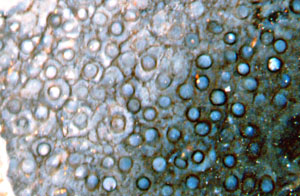On the origin of the pseudo-cellular pattern on
the
surface of nematophytes
Nematophytes
are enigmatic plants consisting of a felt of tubes,
probably kept together by some kind of gel. With some species, like
Nematophyton taiti from
the Rhynie chert, the felt is covered by a
layer consisting of a different type of tubes, aligned perpendicular to
the surface [1].
 If
preserved as coalified patches,
the nematophytes often show a pseudo-cellular surface pattern referred
to as "Nematothallus
cuticle" [2]. As such pattern seems incompatible
with the felt structure, the phenomenon has been repeatedly discussed,
apparently without a conclusive result [3]. It has even been proposed
that the joint ocurrence of pseudo-cellular cuticle and felt of tubes
is due to mere coincidence [4]. The latter can be rejected by evidence
from a recent find in a sample of Rhynie chert (Figs.1,2).
If
preserved as coalified patches,
the nematophytes often show a pseudo-cellular surface pattern referred
to as "Nematothallus
cuticle" [2]. As such pattern seems incompatible
with the felt structure, the phenomenon has been repeatedly discussed,
apparently without a conclusive result [3]. It has even been proposed
that the joint ocurrence of pseudo-cellular cuticle and felt of tubes
is due to mere coincidence [4]. The latter can be rejected by evidence
from a recent find in a sample of Rhynie chert (Figs.1,2).
Fig.1: Nematophyte in Rhynie chert,
cross-section
of a stack of aligned tubes revealing a relation between tubes
and meshes; width of the picture 1.2mm.
 Fig.2:
Nematophyte in Rhynie chert, cross-section of a stack of aligned tubes
with conspicuous meshes
forming a pseudo-cellular pattern ("Nematothallus
cuticle") as occasionally seen on the surface of
coalified nematophytes; width of the picture 0.82mm.
Fig.2:
Nematophyte in Rhynie chert, cross-section of a stack of aligned tubes
with conspicuous meshes
forming a pseudo-cellular pattern ("Nematothallus
cuticle") as occasionally seen on the surface of
coalified nematophytes; width of the picture 0.82mm.
The relation between tubes and meshes is obvious: There is a tube
cross-section in every mesh. Apparently every one of the parallel tubes
produces its own coat of gel. The coats become squeezed by mutual
contact and thus make the pseudo-cellular pattern seen on or below the
surface of the nematophyte. How the
pattern possibly gets onto a cuticle is visualized in Rhynie
Chert News
38
.
Sample: Rh2/81 (0.63kg), obtained
from Shanks
in 2003.
H.-J.
Weiss 2009 2015
[1] R.
Kidston, W.H.
Lang: On Old Red Sandstone plants showing structure ...,
Part V,
Trans. Roy. Soc. Edinburgh 52 (1921),
855-902.
[2] P. K. Strother:
Clarification of the genus Nematothallus,
J. Paleont. 67 (1993), 1090-94.
[3] H. Steur,
W. van der Brugghen:
Nematothallus,
een radselachtige plant ...,
Grondboor & Hamer (1998) Nr.2,
28-35.
[4] D. Edwards:
Fragmentary non-vascular plant microfossils from the Late Silurian of
Wales,
Bot. J. Linnean Soc. 84 (1982),
223-56.
Addendum 2013
Originally, "Nematothallus"
meant a stack of tubes or filaments, often
covered with a cuticle with a pattern as if there had been an
epidermis. As it was not obvious what kind of organism could have
produced both tubes and cuticle, Nematothallus
gave rise to various
interpretations, as revisited in a recent publication [5], where also a
new diagnosis is introduced. According to [5], Nematothallus
denotes
nematophytes with cellular surface layers between cuticle and
filaments, including Silurian fossils with a rather spongy aspect.
Since such diagnosis excludes some nematophytes traditionally named
Nematothallus,
it must be mentioned that the present contribution makes
use of the old concept of Nematothallus
without cellular layers.
As a remarkable development, recently discovered Siluran fossils
resembling Nematothallus
and therefore named Nematothallopsis
[6] (also without intermediate cellular layers) may help to unravel the
nematophyte enigma: "... the most appropriate phylogenetic placement of
Nematothallopsis
– along with Nematothallus
and Cosmochlaina
[*] – is in the ... Coralline Red Algae ..." [6].
* (not in the sense of [5])
[5] D.
Edwards, L. Axe, R.
Honegger:
Contributions to the diversity in cryptogamic covers in the
Mid-Palaeozoic: Nematothallus
revisited.
Botanical Journal of the Linnean
Society, .. (2013) ... .
[6] M.R. Smith,
N.J.
Butterfield:
A new view on Nematothallus:
Coralline Red Algae from the Silurian of Gotland.
Palaeontology 56(2013), 345–357.
 |
 |
30 |


 If
preserved as coalified patches,
the nematophytes often show a pseudo-cellular surface pattern referred
to as "Nematothallus
cuticle" [2]. As such pattern seems incompatible
with the felt structure, the phenomenon has been repeatedly discussed,
apparently without a conclusive result [3]. It has even been proposed
that the joint ocurrence of pseudo-cellular cuticle and felt of tubes
is due to mere coincidence [4]. The latter can be rejected by evidence
from a recent find in a sample of Rhynie chert (Figs.1,2).
If
preserved as coalified patches,
the nematophytes often show a pseudo-cellular surface pattern referred
to as "Nematothallus
cuticle" [2]. As such pattern seems incompatible
with the felt structure, the phenomenon has been repeatedly discussed,
apparently without a conclusive result [3]. It has even been proposed
that the joint ocurrence of pseudo-cellular cuticle and felt of tubes
is due to mere coincidence [4]. The latter can be rejected by evidence
from a recent find in a sample of Rhynie chert (Figs.1,2).  Fig.2:
Nematophyte in Rhynie chert, cross-section of a stack of aligned tubes
with conspicuous meshes
forming a pseudo-cellular pattern ("Nematothallus
cuticle") as occasionally seen on the surface of
coalified nematophytes; width of the picture 0.82mm.
Fig.2:
Nematophyte in Rhynie chert, cross-section of a stack of aligned tubes
with conspicuous meshes
forming a pseudo-cellular pattern ("Nematothallus
cuticle") as occasionally seen on the surface of
coalified nematophytes; width of the picture 0.82mm.
